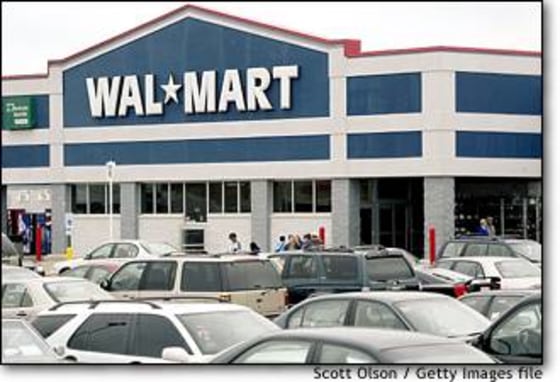With investors still hoping for an economic recovery in the second half of 2003, Wall Street will be listening closely when Wal-Mart reports first-quarter earnings early Tuesday, hoping for clues that consumer spending — the main driver of economic growth — is returning. But judging by the retail group’s April sales performance, analysts aren’t expecting any nice surprises from the retail sector this earnings season.
Last week, Wal-Mart told Wall Street it expects to report earnings of 42 cents a share for the quarter ended April 30, hitting the high end of its previously stated projection of 40 cents to 42 cents per share. A shift toward sales of higher margin apparel has contributed to the gain, analysts say.
The world’s largest retailer also said April same-store sales, a key measure of retail business performance, grew by a weaker-than-expected 4.6 percent, missing expectations for an increase of between 5 and 7 percent.
Other big retailers, such as J.C. Penney and Sears, said April sales fell short of estimates. And some, including department store chain Kohl’s, cut their earnings outlooks, citing such problems as severe weather and merchandising missteps.
J.C. Penney, Kohl’s and Federated Department Stores are due to report quarterly earnings this week.
Retail sector still struggling
From Sears to Target, the retail sector has struggled in the early months of this year, hurt by the war in Iraq, geopolitical instability, unseasonably cold weather and rising unemployment. Wall Street had hoped that a quick end to the war in Iraq would spur consumer spending, but retailers have continued to report tepid monthly sales.
Although its sales have been lackluster, Wal-Mart continues to outperform its peers. Earnings research firm Thomson First Call expects the firm’s earnings to rise 14 percent from the same period a year ago, with revenue rising 10 percent. The broader retail sector is seen rising 3.2 percent for the quarter with revenue climbing 5.9 percent.
“Wal-Mart is facing the same problems as the rest of the retail group, but it’s doing significantly better,” said Ken Perkins, a research analyst at Thomson. ”[The firm] is managing their business well and cutting costs. But the bottom line for these companies is, at what level can the consumer continue to spend?”
Results from Wal-Mart’s Sam’s Club wholesale division, which is facing increased competition from rivals BJ’s Wholesale Club and Costco Wholesale, may continue to disappoint in the first quarter, while food sales are expected to be a major contributor to results. Sales of food at Wal-Mart’s Supercenters rose 25 percent in 2002.
“Wal-Mart’s food sales have grown and come largely at the expense of the rest of the grocery business,” said retail analyst Andrew Wolf at BB&T Capital Markets. “I’m still not recommending companies like Kroger and Safeway because, even though their valuations are low, the competitive pressure from Wal-Mart never abates. It just keeps getting stronger.”
Second-half recovery questioned
Strength in consumer spending, which accounts for about two-thirds of U.S. economic growth, buoyed the economy as it fell into its current slump. But even though consumer sentiment rose smartly in April as the war with Iraq came to an end, the cheerfulness did not translate into more spending, suggesting the consumer may not lead the economy out of its current malaise.
“The bounce back in sales that retailers have been hoping for over the past few months looks like it’s not going to happen,” wrote Patrick McKeigue, a retail analyst at Independence Investments, in a research note.
Consumers are still hunkering down, wary and confused about the direction of the economy, particularly the labor markets, McKeigue said. In April, the nation’s jobless rate jumped to six percent, as businesses cut jobs for the third straight month. “Until and unless we see an improvement in the labor market, this may be as good as it gets for retailers,” McKeigue wrote.
Still, retail stocks have been rallying in anticipation of an economic rebound in the latter half of the year. The sector, as measured by the Standard & Poor’s Retail index, has risen 25 percent from a March 11 low for the year of 245.90. The Standard & Poor’s 500-stock index, a broad measure of the market, has risen 16 percent over the same two-month period.
“If the rebound continues to stay just out of reach, you have to wonder how long investors will wait,” remarked McKeigue, implying that stock prices may decline in the near future if retailers’ sales refuse to grow.
Earnings back on track
Michael Niemira, senior economist at the Bank of Tokyo-Mitsubishi, is more upbeat about the sector’s earnings outlook.
While Niemira thinks the conditions that dogged the sector in the final quarter of 2002 will still apply to the first quarter — namely, war concerns, sluggish sales and a broader economic malaise — he sees sales and earnings getting back on track in the second half of the year.
“Industry-wide, we’re looking for a second-half improvement that should add a couple of percentage points to the pace of sales,” Niemira said. “The question is at what point do the cost pressures become less favorable?” Labor and healthcare costs are rising, he added, and a declining dollar is likely to make imports of electronics and other goods made overseas more costly.
“What this means is retailers are going to have to get their sales up towards the end of the year as the benefit of lowering costs begins to wane relative to future demand,” said Niemira. “Wal-Mart will probably be the first to benefit, as few players in the industry have their clout when dealing with suppliers.”
